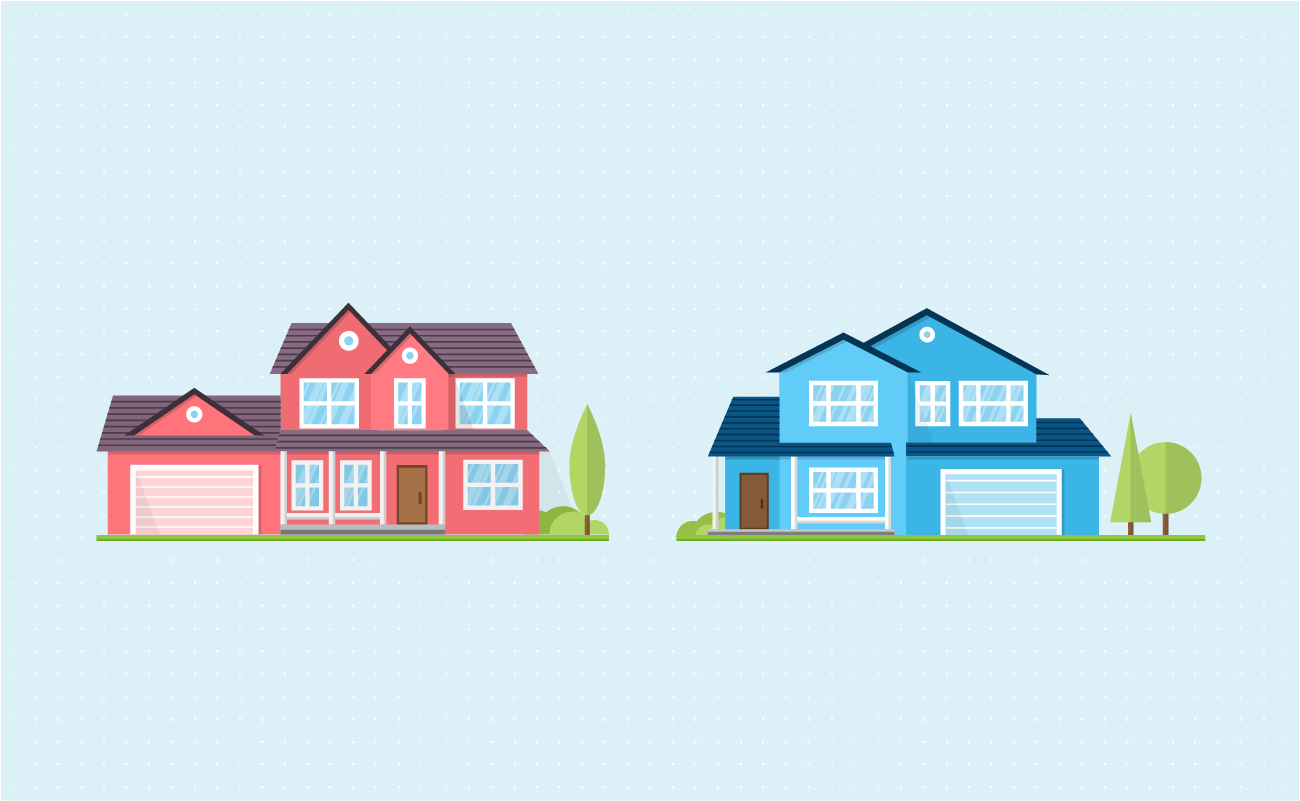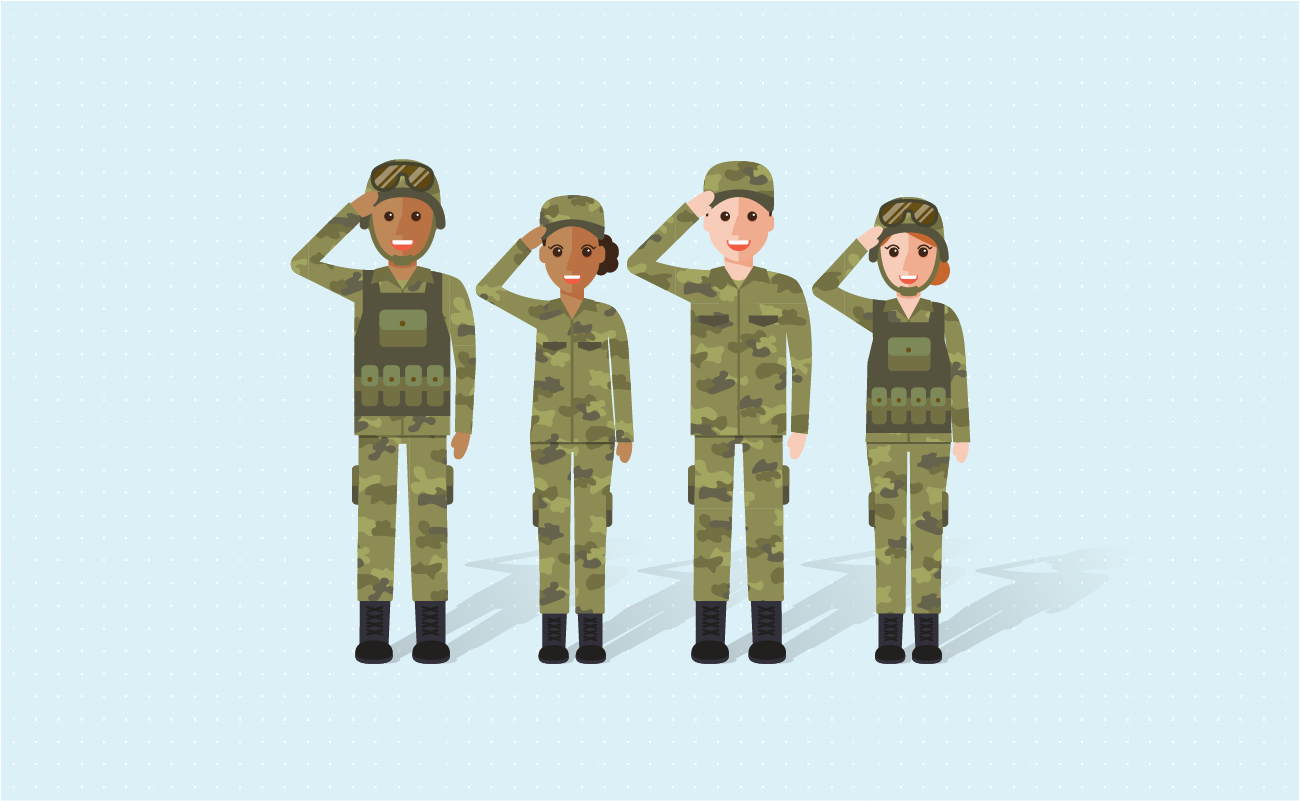Fixed Rates
30 yr
25 yr
20 yr
15 yr
10 yr
Compare Terms
Compare Rates
Real APR
Adjustable Rates
Qualification
Affordability
Renter Affordability
Rent vs Buy
Price per Square Foot
Jumbo
Home Sellers
 VA Mortgage Calculator
VA Mortgage CalculatorThis calculator helps buyers estimate their monthly home loan payments for VA loans.
Guide published by Jose Abuyuan on September 21, 2020

Homebuying comes with many unique financial challenges. On top of saving for a down payment, you must have a good credit score to qualify for a loan. And with strict credit standards in place, it can be more challenging for military members to afford a home.
But don’t fret. You can still own your dream house with help from a VA loan. The VA loan program comes with flexible credit standards and affordable upfront costs for qualified service members and veterans.
Our guide below will discuss how VA loans work, as well as the requirements you need to secure this loan. You’ll learn about the VA funding fee and how it affects your monthly mortgage payments. We’ll also compare VA loans with conventional mortgages and talk about its benefits and disadvantages.
VA loans are mortgages exclusively issued to active-duty members, veterans, and qualifying military spouses. These loans are guaranteed by the U.S. Department of Veterans Affairs, which are provided by lenders such as banks, credit unions, and mortgage companies.
The government developed the VA financing program to assist returning military members. It serves as a valuable alternative to conventional loans with large down payments and strict credit qualifications. Under this program, veterans and active-duty members are entitled to zero down payment (100 percent financing). It also does not charge mortgage insurance premium unlike other government-backed mortgages, such as FHA and USDA loans. But to compensate for taxpayer’s costs, the program enforces a VA funding fee.
The VA loan program was developed in 1944 as part of the World War II GI Bill, otherwise known as the Servicemen’s Readjustment Act. It was signed into law by President Franklin D. Roosevelt as an alternative to bonus checks to improve the economic standing of military members and veterans.
The ArmyTimes.com reports that from the end of World War II to 1966, about a fifth of all single-family housing were constructed and financed through the VA loan program. In 1950, Congress made changes to expand the VA program to more service members. Among those changes included surviving spouses of veterans who died in service or as a result of a service-related disability. Qualified widows were entitled to the benefit as long as they did not remarry.
In 1952, nearly 2.4 million Word War II veterans used VA loans to purchase a home. Between 1944 to 1993, the VA guaranteed around 13.9 million mortgages. Today, the program has issued more than 24 million VA loans, helping generations of military members and veterans afford homes throughout America.
The VA loan program comes with special advantages that are not offered in conventional loans. But there are instances where getting a conventional mortgage might be more beneficial in the long-run. We’ll compare both options and examine their differences closely.

VA loans require no down payment and come with more tolerant credit qualifying standards. This is advantageous for active military and veterans with low credit ratings and tight funds. To qualify for a VA loan, your credit score must be at least 620. This makes VA loans a viable option if you are not eligible for conventional loans. In some cases, lenders may approve a VA loan even if your score is below 620. However, you get better chances of approval if your credit rating is 620 and above.
As for rates, VA loans usually have lower rates compared to conventional mortgages. Because of government guaranty, VA lenders can provide borrowers with competitive rates at favorable terms. The guaranty also helps lenders feel more secure in case borrowers default on their loan.
Next, applicants must satisfy the required debt-to-income ratio (DTI). DTI calculates the percentage of your monthly debts in relation to your total monthly income. It indicates greater risk of default if your DTI is a lot higher than the approved limit. There are two main types of DTI ratios:
For VA loans, the main basis for DTI ratio is the back-end DTI. The VA program requires a back-end DTI of 41 percent. But in some cases, you may qualify with a higher DTI if you have residual income.
Are there loan limits? For VA loans, you can borrow as much money your lender is willing to approve. Just take note that lenders usually have their own criteria for how much you can borrow. VA loan limits only take effect if you currently have another VA loan or if you’ve defaulted on a VA loan in the past.

Though there are no loan limits, the VA program enforces liability limits. This means the VA only guarantees a certain amount on your mortgage. In effect, lenders may put a cap on the loan amount they are willing to approve. This can keep you from buying a more expensive house.
VA funding fee rates vary per borrower. It’s based on your loan amount, down payment, and the kind of VA financing you have. It also increases if you’ve used your VA benefit before. Borrowers have the option to pay this as a one-time closing fee. In many cases, it’s usually rolled into your monthly mortgage payments, which means it’s added to your loan amount. This increases your monthly payments and interest charges.
How does this affect your mortgage? If your loan amount is $300,000, your VA funding fee can be anywhere between $4,200 to $10,800. When added to your loan, your principal balance increases to $304,200 up to $310,800. This expensive cost should make you reconsider that zero-down option. If you have a high funding fee rate, VA loans can be more costly than a conventional mortgage.

Make a small down payment to lower your VA funding fee rate. While paying no down payment seems like a favorable option, you end up with higher monthly payments and interest charges. Likewise, a higher down payment of 5% or more will significantly reduce your VA funding fee rate.
The VA loan program also comes with flexible arrangements, allowing you to have two VA loans at once. This can happen if you’ve purchased a house with a VA loan, but you want to buy a new one. Qualified VA borrowers are allowed to purchase a new house with a VA loan while they still own the first one. After closing the sale, they can sell the first house.
What if you already have a VA loan, but want better terms? Veterans and military members can refinance to a lower rate with favorable terms. This is done through the VA interest rate reduction refinancing loan (IRRRL) program. You also have the option to refinance to a fixed-rate loan or an adjustable-rate mortgage.

Conventional mortgages are the most popular type of home financing used by U.S. homebuyers. In the first quarter of 2020, conventional loans accounted for 68.3 percent of new mortgage originations in the country, according to NAHB.
Unlike VA loans, conventional mortgages do not receive direct government funding. These loans are usually packaged into mortgage-backed securities secured by Freddie Mac and Fannie Mae. Private lenders such as banks, mortgage companies, and credit unions provide these loans.
Without direct government funding, conventional lenders bear the brunt of financing. This puts them at greater risk of financial loss when borrowers fail to pay back their loan. To reduce this risk, conventional lenders impose much stricter credit standards and qualifying requirements than government-backed loans.
To be eligible for a conventional mortgage, lenders prefer a credit score of 700 and above. A higher credit score makes you qualify for more competitive rates. Borrowers with a credit score of 680 are also approved but they typically get higher rates. You’re likely to obtain a better deal if you have an excellent credit rating.
As for DTI ratio, conventional lenders require a front-end DTI no higher than 29 percent. For back-end DTI, the maximum limit is 43 percent. But in practice, most conventional lenders prefer a back-end DTI no higher than 36 percent. Remember, a lower DTI ratio improves your chances of obtaining mortgage approval.
When it comes to down payment, homebuyers are encouraged to make a 20 percent down. However, on average, many borrowers prefer to pay 10 percent down on a conventional mortgage.
At first glance, VA loans certainly have many benefits over conventional mortgages. It provides easier credit qualifying standards and requires no down payment from borrowers. However, despite the affordable closing costs, consider the long-term impact of the VA funding fee. If you don’t make a down payment, the funding fee can substantially raise your monthly mortgage payments and increase your interest costs.
To help you assess the difference between VA loans and conventional mortgages, we made the table below:
| Requirements | VA Loans | Conventional Mortgages |
|---|---|---|
| Credit score | Aim for 620 Flexible credit standards | 700 and above is the ideal score 680 is usually approved by lenders |
| Down payment | No down payment required 5% down upon closing lowers the VA funding fee | 20% – removes PMI 10% – the average down payment 3% – minimum required for 97-3 loan |
| Rates | Has lower rates due to federal backing | A high credit score qualifies you for a lower rate A low credit score gets you a higher rate A low down payment also decreases your rate |
| Front-end DTI | Main basis is back-end DTI | Should not exceed 28% |
| Back-end DTI | Must ideally be 41% DTI can be higher with residual income | Ideally should not exceed 36% Should not be higher than 43% If you have a student loan, up to 50% |
| Cost | Does not require PMI VA funding fee costs between 1.4%-3.5% of the loan amount No prepayment penalty | PMI is 0.5%-1% of the loan amount per year PMI is canceled once mortgage balance reaches 78% Average closing cost is typically 2%-5% of the loan May come with prepayment penalty |

Despite the relaxed credit requirement and the zero-down option, VA loans come with several potential disadvantages.
1
VA loans do not include property inspections during appraisal. You must spend for additional home inspection to make sure the property is free from any structural damages.
2
Next, VA home financing can only be used for primary homes. If you intend to by vacation houses or investment property, this is out of the question. Moreover, since the VA program imposes liability limits, it may reduce the loan amount your lender is willing to approve. This means you may need to find a more affordable home or look for another lender that will grant a larger loan.
3
One major drawback of VA loans is the VA funding fee. This gets higher if you make no down payment at all. Because of this, sometimes VA loans may be more expensive than a conventional loan. If you plan to use your VA benefit again in the future, expect your VA funding fee rate to increase on subsequent uses.
Let’s say you made no down payment and rolled in a VA funding fee into a 30-year fixed-rate loan. The home’s value is $200,000 and the rate is at 3 percent APR. This increases your monthly payments, while the long term makes your lifetime interest costs higher. However, you can save more on interest charges if you choose a conventional mortgage at a similar APR with a 30-year term while paying 20 percent down to avoid PMI, which is the equivalent of a loan funding fee but for conventional loans.
To understand how this works, let’s take a look at the table below.
| Mortgage details | VA Loan | Conventional Mortgage |
|---|---|---|
| VA funding fee / closing costs | $4,600 (funding fee rate: 2.3%) | $4,000 |
| Down payment | None | $40,000 |
| Amount borrowed (loan amount) | $204,600 | $160,000 |
| Monthly principal & interest payment | $862.60 | $674.57 |
| Monthly taxes & insurance | $283.33 | $283.33 |
| Monthly PMI payment | None | $0.00 |
| Total monthly mortgage payment | $1,145.93 | $957.90 |
| Total interest costs | $105,936.67 | $82,843.92 |
We used the calculator above to estimate the VA loan and the mortgage payment calculator to calculate the conventional loan. For the conventional loan no discount points were used and closing costs were not financed in the loan.
Based on the table above, with a VA loan, your loan amount increases to $204,600 if you roll in your VA funding fee into your mortgage. Meanwhile, if you make 20 percent down on the conventional loan, you reduce your loan amount to $160,000, avoiding monthly PMI payments. With the VA loan, your principal and interest payment will be $862.60, while the conventional loan principal and interest payment will be $674.57. That’s a difference of $188.03.
If we compare the total monthly mortgage payment, the VA loan will cost $1,145.93, while the conventional loan will cost $957.90. You’ll pay $188.03 more per month with a VA loan. Finally, the greatest savings is seen in your total interest charges. With a VA loan, you’ll spend $105,936.67 on overall interest costs. But with a conventional loan, you’ll spend $82,843.92 on total interest charges. In this example, you’ll save $23,092.75 on lifetime interest costs if you choose a conventional mortgage with a substantial downpayment.
Take a conventional loan if you have enough funds and a good credit score. This is beneficial especially if you can score a low rate while avoiding monthly PMI payments. However, if you have limited funds and can’t qualify for a conventional loan, it’s worth taking a VA loan instead. Just save up for a down payment to reduce your VA funding fee. Paying a little more now can help you save in the long-term.
To summarize the pros and cons of taking a VA loan, we created the table below:
| Pros | Cons |
|---|---|
| Down payment is not required, offers 100% financing | No down payment = higher funding fee rate |
| Qualify even with a low credit score of 620 | If you roll your VA funding fee into your monthly payments, it increases your loan amount |
| Rates are generally lower than conventional loans | VA funding fees increase each time you reuse your benefits |
| Does not enforce loan limits unlike FHA loans | VA liability limits may prevent you from buying a more expensive home |
| Past bankruptcy or foreclosure will not permanently affect your chances of securing a VA loan | VA appraisals do not include property inspection & closing may take slightly longer |
| No mortgage insurance premium (PMI) | Can't be used for vacation homes or investment property |

To obtain a VA loan, applicants must satisfy the following criteria established by the U.S. Department of Veterans Affairs:
Next, prepare to provide proof of employment and a stable source of income. While the VA program is flexible when it comes to evaluating income and employment, applicants must ideally have at least 2 years of full-time work. If you are a part-time employee or self-employed applicant, the VA usually asks for additional documentation to review your financial background. To improve your chances of approval, it’s best to minimize work gaps and establish a reliable source of funds.
Gather the following documents before applying for a VA loan:
Depending on your situation, lenders may request for the following additional paperwork:
To determine the amount of your VA funding fee rate, refer to the charts below. These are sourced from the official U.S. Department of Veterans Affairs site. All veterans, active-duty members, and staff of the National Guard and Reserves must follow these rates as of January 1, 2020.
VA-backed Purchase and Construction Loans
| If your down payment is… | Your VA funding fee will be… | |
|---|---|---|
| First use | Less than 5% | 2.3% |
| 5% or more | 1.65% | |
| 10% or more | 1.4% | |
| After first use | Less than 5% | 3.6% |
| 5% or more | 1.65% | |
| 10% or more | 1.4% |
For qualified members who only used a VA-backed or VA direct home loan to buy a manufactured house in the past, you still need to pay the first-time funding fee.
VA-backed Cash-Out Refinancing Loans
| First use | After first use |
|---|---|
| 2.3% | 3.6% |
VA funding fee rates for refinancing do not change based on your down payment amount. For those who used a VA-backed or VA direct home loan to buy a manufactured house, you must only pay the first-time use funding fee.
Native American Direct Loan (NADL)
| Type of use | VA funding fee |
|---|---|
| Purchase | 1.25% |
| Refinance | 0.5% |
The VA funding fee rate for this loan does not change based on your down payment amount or if you’ve used your VA benefit in the past.
Other VA Loan Home Types
| Loan type | VA funding fee |
|---|---|
| Interest Rate Reduction Refinancing Loans (IRRRLs) | 0.5% |
| Manufactured home loans (not permanently affixed) | 1% |
| Loan assumptions | 0.5% |
| Vendee loan, for purchasing VA-acquired property | 2.25% |
The VA funding fee rate for this loan does not change based on your down payment amount or if you’ve used your VA benefit in the past.

While the VA funding fee is required, there are certain conditions which merit exemptions. The VA funding fee is waived if a qualified applicant receives disability compensation. These are given to service members who were injured while in service. Active military and veterans may also be exempted from funding fees if they meet the following conditions:
To see the complete list of funding fee exemptions, check the VA funding fee and loan closing costs page.
Apart from VA home purchase loans, there are other kinds of VA programs available to qualified veterans and service members. These options include the following loans:
Borrowers with an existing VA mortgage can apply for VA interest rate reduction refinance loans (IRRRL). This special type of refinancing allows borrowers to reduce their current mortgage payments. Because it refinances your loan, you have the option to change your rate and loan term.
But unlike conventional refinancing, the IRRL does not require strict background checks on your income. It also does not enforce home appraisals. The main qualifications include having a VA-backed home loan or a document that proves you live in or used to live in a house secured by a VA-backed loan.
This allows qualified members to refinance their conventional loan into a VA loan while accessing home equity. It’s beneficial if your current conventional mortgage has a higher rate than a VA loan. VA cash-out refinancing allows borrowers to tap up to 90 percent of their home equity. This limit is higher compared to FHA loans that only allow borrowers to access up to 85 percent home equity.
VA renovation loans allow qualified members to buy or refinance property that needs repairs. This type of financing also comes with zero down payment and low closing costs. It means you can look for an old house and renovate it using your VA benefit. VA renovation loans can also be taken together with a VA purchase loan. However, it only covers common home improvements in similar properties of the same value in an area. The VA program allows lenders to evaluate what they consider acceptable common repairs.

The low credit score requirement and no down payment option makes VA loans appealing to homebuyers. However, how exactly does the VA funding fee affect your mortgage payments? Consider how the funding fee increases when the VA benefit is used subsequently. Also note that the funding fee is affected when you make a down payment.
To learn how this works, let’s use the calculator above. The table below compares identical VA loans with different usage status and down payments. Let’s suppose you took a 30-year fixed-rate loan with a home value of $200,000 at 3 percent APR. One VA loan is on first use, while the other is on first use with 5 percent down. The other VA loan is on its subsequent use, while the next is on subsequent use with 5 percent down.
| Mortgage details | First use, no down payment | First use, less than 5% down | Subsequent use, no down payment | Subsequent use, less than 5% down |
|---|---|---|---|---|
| Upfront funding fee | $4,600 | $4,370 | $7,200 | $6,840 |
| Loan amount | $204,600 | $194,370 | $207,200 | $196,840 |
| Monthly principal & interest payment | $862.60 | $819.47 | $873.56 | $829.89 |
| Monthly taxes, insurance, HOA | $283.33 | $283.33 | $283.33 | $283.33 |
| Total monthly mortgage payment | $1,145.93 | $1,102.80 | $1,156.89 | $1,113.22 |
| Total interest | $105,936.67 | $100,639.83 | $107,282.88 | $101,918.74 |
Based on the results above, if you make no down payment on the first use, your upfront funding fee will be $4,600. When you roll this into your monthly payments, it increases your loan amount to $204,600. On the other hand, if you make less than 5 percent down, it reduces your loan amount to $194,370, while your VA funding fee decreases to $4,370. Without a down payment, your total monthly mortgage payment will be $1,145.93, while paying less than 5 percent down will reduce it to $1,102.80. That’s savings worth $43.13 per month.
When it comes to total interest costs, you’ll spend $105,936.67 without a down payment, while you’ll spend $100,639.83 with less than 5 percent down. In this example, you’ll save $5,296.84 in total interest charges if you make a small down payment.
On the other hand, notice the significant increase in upfront fee with subsequent use. If you make no down payment on a subsequently used VA benefit, the funding fee increases to $7,200. That’s because the rate increases to 3.6 after the first use. This raises your loan amount to $207,200. Meanwhile, if you make less than 5 percent down, it decreases your loan amount to $196,840, while your funding fee is reduced to $6,840.
Comparing the total monthly mortgage payments, it will be $1,156.89 if you make no down payment on subsequent use. On the other hand, with less than 5 percent down, it will be $1,113.22. You’ll save $43.67 per month if you make a small down payment. And when it comes to over all interest costs, you’ll spend $107,282.88 on subsequent use without a down payment. Meanwhile, you’ll spend $101,918.74 if you pay less than 5 percent down. You’ll save a total of $5,364.14 in interest charges if you make a small down payment with subsequent use of your VA loan.
The results above show that it’s worth making a down payment to reduce your VA loan’s interest costs. Likewise, if you want greater interest savings, you must increase your down payment to reduce the funding fee rate. Moreover, take note of the funding fee increase with subsequent use. If you have a good credit score, it’s worth taking a low interest conventional loan to avoid the expensive VA funding fee.

VA loans are special mortgages that assist veterans and active-duty military in affording homes. The VA program is a good fit for qualified members who have limited income and low credit scores. If you’re a service member who cannot qualify for a conventional mortgage, consider this option.
But take note of the main drawback. Though VA loans do not require mortgage insurance premium, you must pay a VA funding fee. This extra cost is based on your loan amount, down payment, and whether you’ve used your VA benefit in the past. If you do not pay it upon closing, it’s rolled into your monthly mortgage payments. This increases your loan amount, which also makes your monthly payments higher. However, the VA funding fee can be waived especially if you’ve suffered an injury or disability during service.
To reduce the VA funding fee, save for a down payment. Even a small amount will help lower your funding fee rate, which helps reduce your monthly payments and overall interest costs.